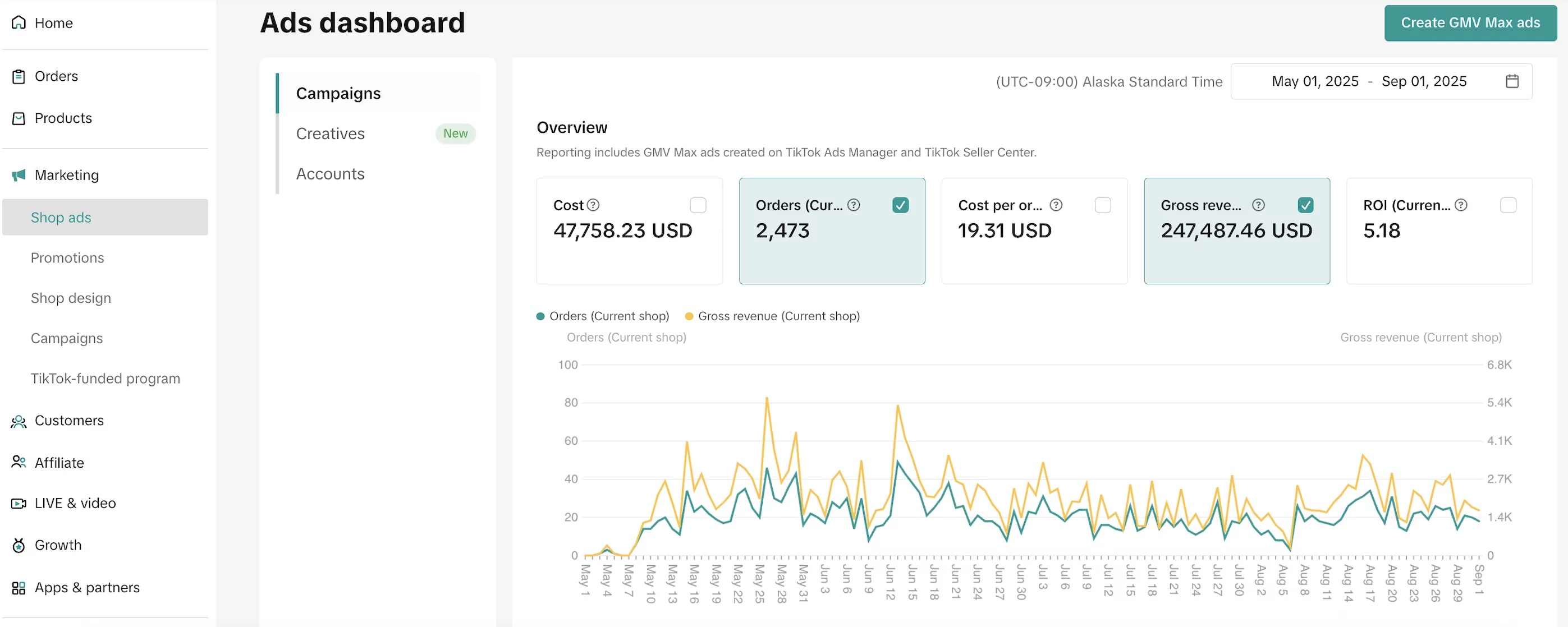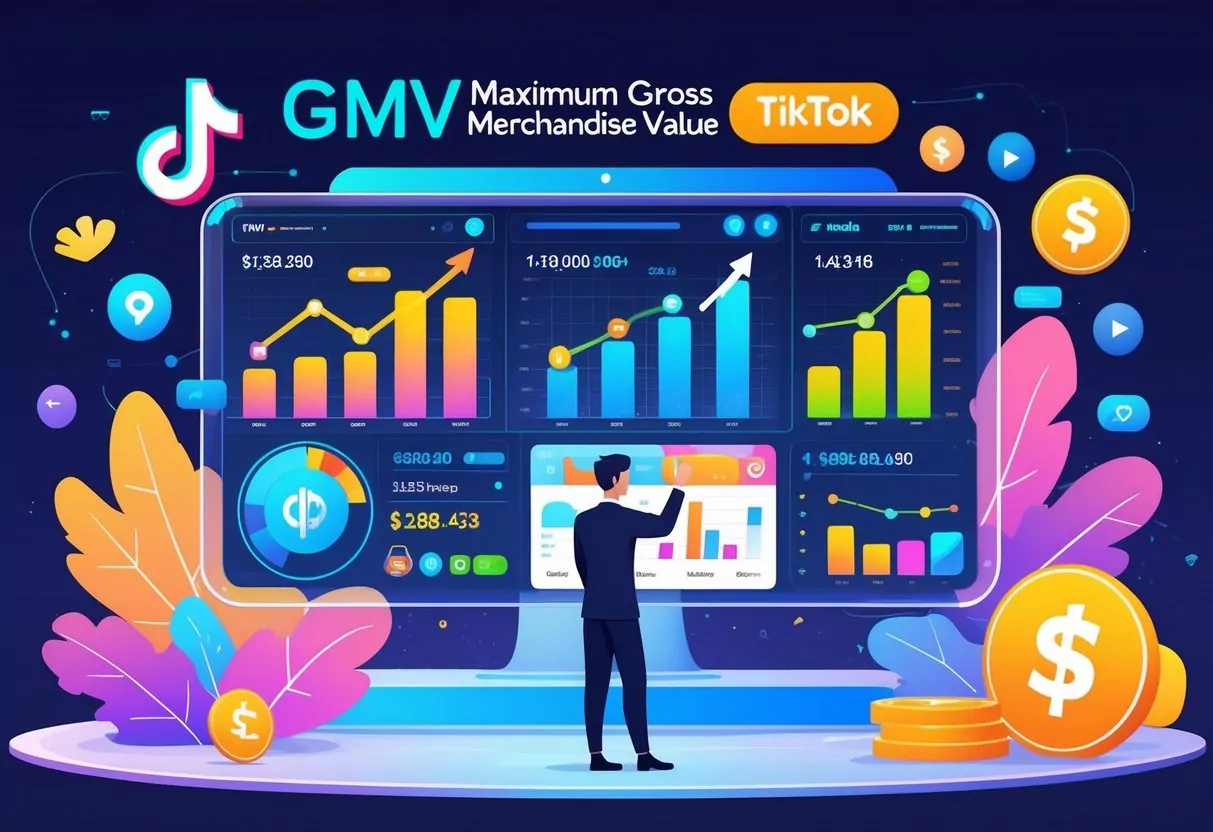A small e-commerce brand turned a modest $6,000 ad spend into $45,000 in gross merchandise value (GMV) on TikTok Shop. The campaign proved that with the right creative direction, audience targeting, and product positioning, even limited budgets can drive strong returns. This case study shows how data-driven decisions and smart optimization can multiply results without increasing ad costs.
The team focused on understanding consumer behavior, refining ad visuals, and structuring campaigns for maximum reach and conversion. Each step built on measurable insights rather than guesswork, allowing them to scale efficiently while maintaining profitability.
This article explores how they planned, executed, and optimized their TikTok Shop strategy to achieve these results. It also covers the challenges they faced, how they solved them, and the lessons that can help other brands improve their paid ad performance.
Campaign Overview and Results
The campaign used TikTok Shop’s GMV Max ads to automate creative optimization and reach high-intent shoppers. With a $6,000 budget, it focused on efficient bidding, consistent organic engagement, and data-driven targeting to generate $45,000 in gross merchandise value (GMV).
$6K Ad Spend Breakdown
The $6,000 investment covered three main areas: creative production (15%), paid media (70%), and testing and optimization (15%). Paid media received the largest share to maximize reach and conversion within TikTok Shop’s ad ecosystem.
The team relied on TikTok’s GMV Max campaign type, which automatically selected top-performing creatives from organic videos and Spark Ads. This automation reduced manual management time and ensured ad spend went toward content with proven engagement.
A small portion of the budget funded Product Shopping Ads, which used existing product listings and shop imagery. This helped capture users browsing within the Shop Tab, complementing the broader reach of the GMV Max campaign.
Achieving $45K GMV
The campaign achieved $45,000 in GMV, translating to a 7.5x return on ad spend (ROAS). This result came from combining automated optimization with consistent organic posting.
TikTok’s algorithm used signals from both paid and organic videos to identify high-performing content. As a result, ads reached users more likely to purchase. The brand maintained a steady posting schedule of short, educational clips that matched the tone of TikTok’s community.
Increased visibility led to higher product sell-through and repeat purchases. Inventory turnover improved, and the brand expanded its reach to new customer segments who discovered products through Spark Ads and Shop Tab exposure.
Key Performance Metrics
The campaign tracked several core metrics to measure success:
| Metric | Result |
|---|---|
| Total Ad Spend | $6,000 |
| Gross Merchandise Value (GMV) | $45,000 |
| Return on Ad Spend (ROAS) | 7.5x |
| Click-Through Rate (CTR) | 2.8% |
| Conversion Rate | 4.5% |
Engagement rates stayed above platform averages, showing strong audience interest. The automated optimization in GMV Max helped allocate budget toward creatives with the best conversion data, keeping cost per acquisition low and maintaining consistent revenue growth throughout the campaign period.
TikTok Shop Strategy
The campaign used data-driven content, a clear creative system, and careful product curation to turn a small ad budget into strong sales results. Each step focused on building trust, improving visibility, and converting attention into measurable performance.

how signalytics helped client achieve target Tiktok GMV target
Content Creation Approach
The team built short-form videos that matched trending TikTok styles while staying true to the brand’s tone. Each video aimed to show the product in real use, keeping the focus on benefits instead of heavy promotion.
Creators played a key role. They produced authentic clips that blended with organic content, helping the brand reach new audiences. The team tracked watch time, click-through rate, and add-to-cart actions to decide which videos to scale.
A mix of Shop Ads and creator posts ensured both paid reach and organic engagement. This balance helped the campaign maintain credibility while driving consistent traffic to the TikTok Shop page.
4 R’s Framework: Reactions, Replies, Retarget, Repurpose
The campaign followed a simple framework to guide daily actions:
| Step | Purpose | Example |
|---|---|---|
| Reactions | Engage with trending sounds or comments | Duet or stitch with viral clips to boost visibility |
| Replies | Respond to user questions or feedback | Use short video replies to address common concerns |
| Retarget | Re-engage interested viewers | Serve ads to users who viewed or added items to cart |
| Repurpose | Reuse top content in new formats | Turn high-performing clips into ad creatives or live demos |
This approach kept content fresh and responsive. It also reduced creative waste by reusing proven material while maintaining relevance to audience behavior.
Product Selection Process
The team selected products with strong visual appeal and quick demonstration value. Items that solved a clear problem or had a “wow” factor performed best on TikTok.
They analyzed platform analytics to find categories with high engagement and low competition. Pricing stayed within impulse-buy range, usually under $50, to encourage quick decisions.
Each product listing included short, clear descriptions and user-generated videos showing real results. This transparency built trust and helped convert casual viewers into buyers.
Execution and Optimization
The team focused on refining creative performance, scaling high-performing campaigns, and improving conversion efficiency. Each step aimed to increase gross merchandise value (GMV) while maintaining a healthy return on ad spend (ROAS).
Ad Creative Testing
They began with A/B testing across multiple short-form videos. Each creative highlighted a single product benefit, paired with captions and on-screen text that matched trending TikTok styles.
Testing ran for three to five days under Max Delivery Optimization, which ensured full budget use and fast data collection. The team tracked click-through rate (CTR), cost per acquisition (CPA), and GMV contribution to identify top performers.
Once clear winners emerged, poor-performing creatives were paused. The team then refined the best videos by adjusting hooks, visuals, and captions. This continuous testing loop helped maintain ad freshness and prevent audience fatigue.
| Metric | Goal | Result |
|---|---|---|
| CTR | >2.5% | 3.1% |
| CPA | <$10 | $8.40 |
| GMV per Creative | — | $12K+ |
Scaling Winning Campaigns
After identifying the best-performing creatives, the team allocated more budget using GMV Max. This automated mode optimized bidding and delivery toward higher gross revenue.
They followed a structured scaling plan:
- Increase daily budget by 20–30% every two days.
- Maintain stable ROAS above 4.0 before further scaling.
- Test new audience segments using lookalike and interest-based targeting.
Scaling was supported by Spark Ads, which reused organic posts with proven engagement. This approach kept ad content authentic and reduced production time.
The campaigns were monitored daily to ensure delivery efficiency. When performance dipped, the team rotated creatives or adjusted targeting to sustain momentum.
Conversion Rate Improvements
To improve conversion rates, the team focused on the TikTok Shop product page and checkout experience. They simplified product descriptions, added clear pricing, and used short, informative videos showing product use.
They also leveraged Product Shopping Ads to reach users already browsing in the Shop Tab. These ads used existing product images, minimizing creative effort while improving intent-based targeting.
User feedback showed that concise product details and visible shipping times increased trust. By aligning ad messaging with the landing page and ensuring fast page loads, the team lifted conversion rates by 18% within two weeks.
Challenges and Solutions
The campaign faced several operational and performance hurdles that affected ad efficiency, product availability, and visibility. Each issue required a practical fix using data-driven adjustments and platform tools to maintain steady growth and return on investment.
Overcoming Ad Fatigue
Ad fatigue appeared after the first week when impressions stayed high but click-through rates dropped. The creative rotation slowed, and repeat viewers began to ignore the ads.
The team used GMV Max automation to test new combinations of organic videos, affiliate clips, and paid creatives. This reduced manual workload and refreshed ad delivery daily.
They tracked engagement metrics—CTR, conversion rate, and cost per acquisition—in TikTok Ads Manager. When performance dipped below target, new creatives were added, and underperforming ones paused automatically.
A simple tracking table helped monitor results:
| Metric | Before Refresh | After Refresh |
|---|---|---|
| CTR | 0.9% | 1.8% |
| CPA | $8.40 | $5.60 |
Consistent creative testing and automated optimization helped sustain viewer interest and improve ROI.
Managing Inventory and Fulfillment
Sales volume rose faster than expected, causing temporary stockouts. This disrupted ad delivery since TikTok Shop pauses listings when items run out.
The team linked ad performance data with inventory reports to forecast demand more accurately. They set reorder alerts once stock dropped below 25% of average weekly sales.
To reduce fulfillment delays, they used TikTok Shop’s integrated logistics and pre-packed best-selling items for faster dispatch. The seller dashboard helped track shipping times and cancel rates in real time.
These steps ensured that ad spend aligned with available inventory and that customers received products without delay, protecting both conversion rates and seller ratings.
Adapting to TikTok Algorithm Changes
Midway through the campaign, TikTok updated its commerce algorithm, which shifted traffic toward higher-engagement content. Organic reach for product videos dropped, affecting ad visibility.
The team analyzed engagement signals—watch time, comments, and saves—to identify what content the algorithm favored. They then adjusted creative strategy toward shorter, high-retention clips and increased livestream frequency.
Using GMV Max’s automated optimization, they let the system reallocate budget toward ads with stronger engagement metrics. This maintained consistent delivery even as algorithm priorities changed.
Regular data reviews and flexible creative planning helped the campaign stay aligned with TikTok’s evolving recommendation system.
Key Takeaways and Lessons Learned
Strong results on TikTok Shop depend on smart creative use, data-driven optimization, and consistent testing. Brands that align content style, targeting, and automation tools see higher returns and faster learning cycles.
Essential Success Factors
A clear understanding of the target audience helped the campaign reach high-intent shoppers. The team used Spark Ads to turn proven organic videos into paid content, keeping messaging consistent and authentic. This approach built trust and improved click-through rates.
Automated tools such as GMV Max simplified campaign management. By optimizing across creative, bidding, and targeting, the team spent less time on manual adjustments and more on refining content quality.
Balanced creative strategy also played a key role. Educational and product-focused videos performed best when paired with short, engaging captions. Testing different hooks and visuals helped identify what drove the most conversions.
| Factor | Impact |
|---|---|
| Spark Ads | Maintained brand voice and improved engagement |
| GMV Max | Increased efficiency and sales optimization |
| Audience Insight | Improved ad relevance and conversion rate |
Common Pitfalls to Avoid
Many advertisers overspend early without testing small segments first. This campaign avoided that by starting with limited budgets, learning which audiences performed best, and scaling only after confirming results.
Relying only on viral-style videos often leads to inconsistent sales. The team found that educational or problem-solving content encouraged repeat purchases more than trend-based clips.
Neglecting product availability also caused short-term issues. Inventory sold out multiple times, disrupting ad delivery and hurting momentum. Maintaining stock alignment with ad pacing proved essential.
Other frequent mistakes include ignoring post-purchase engagement and failing to track full funnel metrics. Measuring both ad-driven and organic sales gave a more accurate picture of total performance.
Actionable Tips for TikTok Shop Growth
- Use automation tools like GMV Max to handle optimization and save time.
- Leverage proven organic content through Spark Ads to keep authenticity.
- Test creative formats weekly to refine what resonates with shoppers.
- Track cross-channel sales to understand TikTok’s real impact.
- Plan inventory around expected ad peaks to prevent stockouts.
Brands that apply these steps can build steady growth while keeping ad costs efficient and performance measurable.





